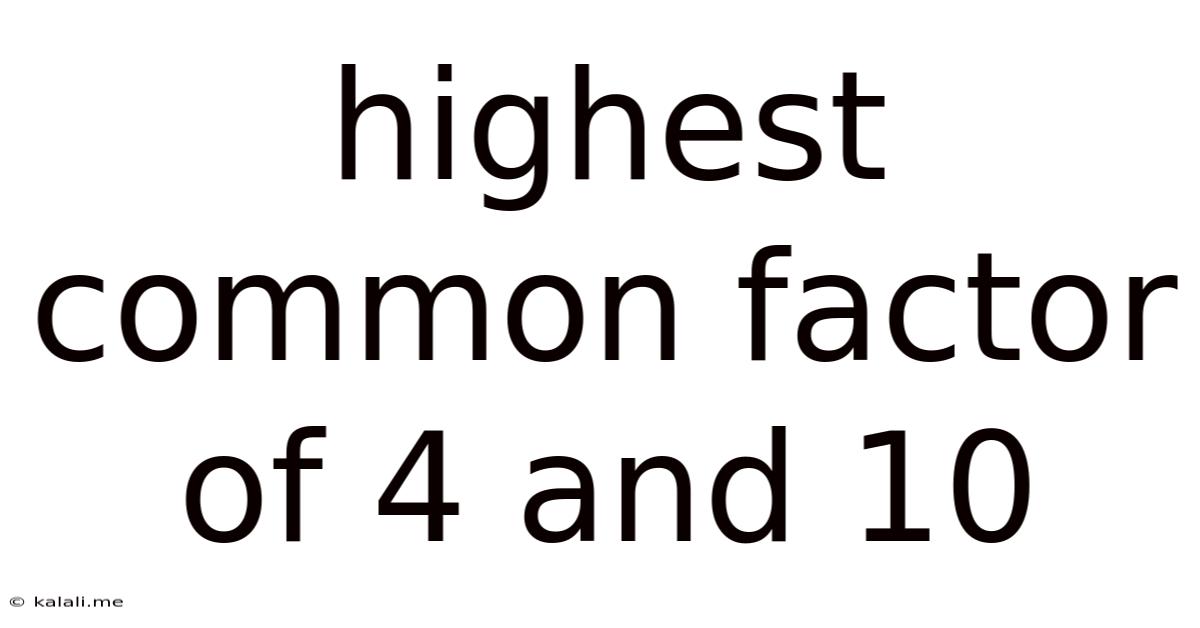Highest Common Factor Of 4 And 10
Kalali
Jun 11, 2025 · 3 min read

Table of Contents
Finding the Highest Common Factor (HCF) of 4 and 10: A Step-by-Step Guide
This article will guide you through finding the highest common factor (HCF), also known as the greatest common divisor (GCD), of 4 and 10. Understanding HCF is crucial in various mathematical applications, from simplifying fractions to solving algebraic equations. We'll explore several methods to determine the HCF, making this concept clear and accessible. By the end, you'll be able to confidently calculate the HCF of not just 4 and 10, but other numbers as well.
Understanding Highest Common Factor (HCF)
The highest common factor (HCF) of two or more numbers is the largest number that divides each of them without leaving a remainder. In simpler terms, it's the biggest number that's a factor of all the given numbers. For example, the factors of 12 are 1, 2, 3, 4, 6, and 12. The factors of 18 are 1, 2, 3, 6, 9, and 18. The common factors of 12 and 18 are 1, 2, 3, and 6. Therefore, the highest common factor of 12 and 18 is 6.
Method 1: Listing Factors
This method is suitable for smaller numbers. Let's find the HCF of 4 and 10:
- List the factors of 4: 1, 2, 4
- List the factors of 10: 1, 2, 5, 10
- Identify the common factors: 1, 2
- The highest common factor is 2.
Therefore, the HCF of 4 and 10 is 2.
Method 2: Prime Factorization
This method is more efficient for larger numbers. It involves finding the prime factors of each number and identifying the common ones.
- Find the prime factorization of 4: 2 x 2 = 2²
- Find the prime factorization of 10: 2 x 5
- Identify the common prime factors: 2 (appears once in both factorizations)
- Multiply the common prime factors: 2
- The highest common factor is 2.
Again, the HCF of 4 and 10 is 2.
Method 3: Euclidean Algorithm (For Larger Numbers)
The Euclidean algorithm is a highly efficient method for finding the HCF of larger numbers. It involves repeatedly applying the division algorithm until the remainder is 0. The last non-zero remainder is the HCF. While not strictly necessary for 4 and 10, it's a valuable technique to learn:
- Divide the larger number (10) by the smaller number (4): 10 ÷ 4 = 2 with a remainder of 2.
- Replace the larger number with the smaller number (4) and the smaller number with the remainder (2).
- Divide 4 by 2: 4 ÷ 2 = 2 with a remainder of 0.
- The last non-zero remainder is 2, so the HCF is 2.
Conclusion
We've explored three different methods to find the highest common factor of 4 and 10, all leading to the same answer: 2. Choosing the most appropriate method depends on the size and complexity of the numbers involved. Understanding HCF is a fundamental concept in mathematics with various practical applications. Now you have the tools to confidently calculate the HCF of any pair of numbers.
Latest Posts
Latest Posts
-
How Far Is 38 Miles In Minutes
Jul 02, 2025
-
How Big Is 500 Acres In Football Fields
Jul 02, 2025
-
In What Order Are Items Placed On A Map Index
Jul 02, 2025
-
How Many Tomatoes Are In A Bottle Of Ketchup
Jul 02, 2025
-
If I Was Born In 1967 How Old Am I
Jul 02, 2025
Related Post
Thank you for visiting our website which covers about Highest Common Factor Of 4 And 10 . We hope the information provided has been useful to you. Feel free to contact us if you have any questions or need further assistance. See you next time and don't miss to bookmark.